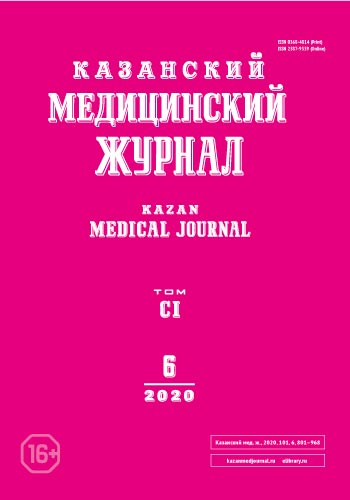Anatomical aspects of the use of the thoracodorsal nerve as a donor in musculocutaneous nerve injury
- Authors: Gorbunov NS1,2, Kober KV1, Kasparov EV2
-
Affiliations:
- Krasnoyarsk State Medical University named after V.F. Voino-Yasenetsky
- Research Institute of Medical issues of the North
- Issue: Vol 101, No 6 (2020)
- Pages: 820-824
- Section: Experimental medicine
- Submitted: 27.08.2020
- Accepted: 29.09.2020
- Published: 14.12.2020
- URL: https://kazanmedjournal.ru/kazanmedj/article/view/43174
- DOI: https://doi.org/10.17816/KMJ2020-820
- ID: 43174
Cite item
Abstract
Aim. To assess the anatomical possibility of the use of the thoracodorsal nerve as a donor for nerve transfer to the musculocutaneous nerve.
Methods. Anatomical dissection of the brachial plexus with layer-by-layer dissection of secondary bundles, short and long branches was performed in 121 male and female corpses. The localization of the origin of thoracodorsal and musculocutaneous nerves relative to the clavicle, the takeoff angle (degrees) from the secondary bundle, the length (in centimeters) of the nerves from the site of origin to the latissimus dorsi muscle entry point and the perforation of the coracobrachialis muscle, respectively, were investigated. The length of the thoracodorsal nerve with and without extramuscular branches was studied separately.
Results. It was revealed that, in 58.7% of cases, the thoracodorsal nerve has the optimal length required for transposition to the musculocutaneous nerve. The excess length of the thoracodorsal nerve was between 0.1 and 9.1 cm. In 41.3% of cases, the length of the thoracodorsal nerve is not enough for transposition. Of these, in 17.4% of cases, the shortage of the length of the thoracodorsal nerve was –2 cm or less, which categorically does not allow its transfer to the musculocutaneous nerve. Only in 5% of cases, the length of the nerve was not enough for transposition in the use of the thoracodorsal nerve with extramuscular branches.
Conclusion. Due to tension in many cases, the thoracodorsal nerve transfer to the musculocutaneous nerve can be performed with difficulty, and in some cases it is impossible, solving the problem in this category of people dictates the development of new surgical techniques with the thoracodorsal nerve or the use of another nerve as a donor.
Full Text
About the authors
N S Gorbunov
Krasnoyarsk State Medical University named after V.F. Voino-Yasenetsky; Research Institute of Medical issues of the North
Email: gorbunov_ns@mail.ru
ORCID iD: 0000-0003-4809-4491
ResearcherId: W-4527-2017
Russian Federation, Krasnoyarsk, Russia; Krasnoyarsk, Russia
K V Kober
Krasnoyarsk State Medical University named after V.F. Voino-Yasenetsky
Author for correspondence.
Email: k-kober@mail.ru
ORCID iD: 0000-0001-5209-182X
ResearcherId: D-9666-2019
Russian Federation, Krasnoyarsk, Russia
E V Kasparov
Research Institute of Medical issues of the North
Email: clinic@impn.ru
ORCID iD: 0000-0002-5988-1688
ResearcherId: C-3621-2018
Russian Federation, Krasnoyarsk, Russia
References
- Chuang D.C. Distal nerve transfer: Perspective of reconstructive microsurgery. J. Reconst. Microsurg. 2018; 34 (9): 675–677. doi: 10.1055/s-0038-1639369.
- Griffin M.F., Malahias M., Hindocha S., Khan W.S. Peripheral nerve injury: Principles for repair and regeneration. Open Orthop. J. 2014; 8: 199–203. doi: 10.2174/1874325001408010199.
- Samardzić M., Rasulić L., Lakićević N., Bascarević V. Collateral branches of the brachial plexus as donors in nerve transfers. Vojnosanit. Pregl. 2012; 69 (7): 594–603. doi: 10.2298/VSP110301007S.
- Kaiser R., Waldauf P., Haninec P. Types and severity of operated supraclavicular brachial plexus injuries caused by traffic accidents. Acta. Neurochir. (Wien). 2012; 154 (7): 1293–1297. doi: 10.1007/s00701-012-1291-7.
- Kober K.V., Gorbunov N.S., Sindeeva L.V., Сhikun V.I. Macro-anatomic and intrainal structure of the thoracodorsal nerve. Modern problems of science and education. 2019; (3): 133. (In Russ.)
- Foroni L., Siqueira M.G., Martins R.S., Oliveira G.P. The intercostobrachial nerve as a sensory donor for hand reinnervation in brachial plexus reconstruction is a feasible technique and may be useful for restoring sensation. Arq. NeuroPsiquiatr. 2017; 75 (7): 439–445. doi: 10.1590/0004-282x20170073.
- Soldado F., Ghizoni M.F., Bertelli J. Thoracodorsal nerve transfer for elbow flexion reconstruction in infraclavicular brachial. J. Hand. Surg. Am. 2014; 39 (9): 1766–1770. doi: 10.1016/j.jhsa.2014.04.043.
- Malalasekera A., Beneragama T., Kanesu S. et al. Extra and intramuscular distribution of the thoracodorsal nerve with regard to nerve reconstruction surgeries. J. Reconstr. Microsurg. 2016; 32 (5): 358–360. doi: 10.1055/s-0036-1579541.
- Schreiber J.J., Byun D.J., Khair M.M. et al. Optimal axon counts for brachial plexus nerve transfers to restore elbow flexion. Plas. Reconstruct. Surg. 2015; 135 (1): 135e–141e. doi: 10.1097/prs.0000000000000795.
- Patel R., Oberhofer H., OʼNeill D. et al. Is thoracodorsal nerve transection needed in latissimus dorsi breast reconstruction? Ann. Plast. Surg. 2020; 84 (6S, suppl. 5): S393–S395. doi: 10.1097/SAP.0000000000002281.
- Novak C.B., Mackinnon S.E., Tung T.H.H. Patient outcome following a thoracodorsal to musculocutaneous nerve transfer for reconstruction of elbow flexion. Br. J. Plast. Surg. 2002; 55 (5): 416–419. doi: 10.1054/bjps.2002.3859.
- Novikov M.L., Torno T.E. Traumatic injuries of brachial plexus: present methods of surgical treatment. Part II. Treatment policy for brachial plexus injuries. Neuromuscular diseases. 2013; (1): 18–26. (In Russ.)
- Millesi H. The nerve gap: theory and clinical practice. Hand. Clin. 1987; 2: 651–663. PMID: 3539948.
Supplementary files










